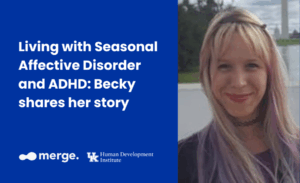Join Patti Singleton, Division Director for Professional Learning, as she discusses plain language with HDI staff, Bev Harp and Morgan Turner. Learn what Plain Language is, why it is important, and how you can get started with using Plain Language. You can also learn more at plainlanguage.gov
Patti Singleton
Thank you for tuning in to the State of HDI, a University of Kentucky Human Development Institute podcast. This is Patti Singleton. I have Bev Harp and Morgan Turner in the studio today. Bev is the project director for HDIs Innovative Supports for Autistic Workers and is an autistic self-advocate. Morgan is a program education assistant with HDIs Health and Wellness projects.
Today’s topic is plain language, a concept important when we talk about universal design. Bev, to start, tell me what plain language means to you.
Bev Harp
Plain Language is a way of making your writing accessible to everyone. Sometimes we think of plain language in terms of intellectual disability, but many other people benefit from plain language writing as well. People learning English as a second language, maybe. Really anyone who is just too busy to read a long, complicated article at the moment. People who are in a rush, people who process information a little differently.
The idea is to say what you need to say in simple familiar terms, using shorter sentences, shorter paragraphs, using bullet points where possible rather than long paragraphs using headings to separate different ideas. The intent of plain language is to at least somewhat level the playing field. The idea that certain information and ideas are only for certain people, the most educated, the most privileged, is damaging not only to the individual but to society.
The US government acknowledged this with the 2010 Plain Language Act, which requires federal agencies to use language that can be understood by most citizens. You shouldn’t need a lawyer every time you need to sign a government form. Not everyone can afford that, which is just one of the ways intentionally obtuse language gives preference to the privileged.
Patti Singleton
That’s a great summary Bev, and I really appreciate that. I know that as a mom and as a professional, it’s hard for me to process all the information that’s thrown at me. And I often say that I need plain language because I need those. That information that’s being presented to me to be very clear and concise. So, thank you for that.
So, Morgan, now to you. Why do you think that we need plain language?
Morgan Turner
Well, one, I think we need plain language to help people. But then I also feel like plain language is a form of universal design. When you think of what universal design is, it’s something that helps people in their everyday life. And I feel like its plain language is universal design, because if someone says a big medical term or if there’s a long email or something, you can say, Hey, I don’t understand this.
Morgan Turner
And then that way, at least in my experience, I feel like people will narrate it in a way that I can understand.
Patti Singleton
Those are really great points, Morgan. And we work a lot together on the health and wellness in trying to help people understand what medical terms and medical concepts mean. And that that is so important that everyone understands what those what those concepts are. So, Bev, if someone was just getting started trying to make their information plain language, where is a good place to get started?
Bev Harp
The website plainlanguage.gov has most of what you’ll need. They have a lot of stuff there and give examples in writing and also in videos. I believe HDI also has some plain language resources. Another way to answer this question is that you should start from the beginning. Like Morgan said. Plain language is a key part of what we call Universal Design for Learning, which is all about providing information in a variety of ways, so no one is left out.
So, if you’re teaching a course about elephants, for example, you’re not going to have just a dense textbook full of facts about elephants. You’re also going to want to have some pictures of elephants, videos, graphs, charts, maybe a podcast that you include in the course materials. It’s a way of acknowledging that people have different abilities relative to vision, hearing, cognitive processing, and also different backgrounds and histories that impact how they learn.
Or maybe their starting point is a little different from average because they haven’t been exposed to the same ideas you have. So if you really want to be universally accessible, you can try writing in plain language whenever possible. This affords the work of having to go back and make a second version, and that’s a great benefit of universal design as it can save you some work later on.
Patti Singleton
Absolutely. And you really touched on some of the points of another part of Universal Design, which is Universal Design for Learning. And we do have a lot of those resources, as you mentioned, and we’ll make sure to post those in the show notes. So, Morgan, back to you. What tips do you have for anyone writing in plain language?
Morgan Turner
My tip would be know your audience. If you’re if you’re wanting your audience to be someone people with disabilities, you wouldn’t make long, lengthy paragraphs or… or something hard to word out. Or like long, long sentences and long words that or big words that people don’t understand. So, I would just say, know your audience and yeah, know your audience.
Patti Singleton
That’s really good. And that’s a good point because plain language is more than just the words that we choose and the information that we convey. It’s also the organization and making sure that we’re using headings and that, you know, it looks visually appealing. So that was really good. All right. And Bev, so what are some mistakes you see people making when they try to write in plain language?
Bev Harp
The biggest one I see is leaving out information. Like the original document might be 12 pages. And then there’s a plain language summary of one or two pages. That’s a good start. And I don’t want to discourage anybody from doing that. It’s way better than not having a summary. But writing plain language is not just about using fewer words.
It’s not a matter of just hitting the main points because we might assume or intended audience won’t be interested or won’t be able to understand. It’s the writer’s responsibility to make sure that everyone has access to the same information. And we can do this, it just takes a little bit of practice. If there are necessary terms that might be unfamiliar to some people, introduce and define them rather than leaving them out.
Say I wanted to write about the autistic rights movement. I would need to talk about neurodiversity because it’s a key concept. One way to do that is to just to put a brief definition in parentheses after the word if there are multiple terms that need to be defined. You can do that at the end of the document or at the end of the section.
So, when you use a word like neurodiversity, for example, the software you use to check the reading level may tell you it’s inaccessible. That’s okay. You can sometimes disregard that on a case by case basis, as long as you’re sure you’ve provided an adequate and accessible definition. Don’t get so hung up on counting the number of letters in a word, the number of words in a sentence. Focus first on overall clarity of your message.
Another thing is that we don’t want to confuse plain language writing with a lower level of formality. Like if you wouldn’t use slang in the original document, don’t use it in the plain language version. Jargon that applies to certain fields, that is something that you will want to translate into regular words for plain language.
So instead of saying a study of an ethnographic exploration of the deaf community, you might say a study about people who are deaf and their culture. So you end up with more words in that case. But that’s okay because you’ve made it clear to people who generally don’t read research papers. To me, the most important thing to remember is respect for your audience.
Don’t oversimplify to the point that you lose much of the meaning and nuance.
Patti Singleton
Bev, I see a broader use of plain language. So, what does the future look like for plain language?
Bev Harp
I’ve been seeing that too; more examples of plain language in the wild. It’s encouraging. Some types of information should always be provided in plain language, like public health information, voting information. It’s easy to see how everyone should have access to those sorts of knowledge. It’s been a little slower progress in understanding that all types of information should be shared in multiple ways so that we all have access.
Even some medical journals have started to provide plain language summaries of articles, and that’s incredible progress over just the last few years. I did not expect to see it. Recently, I saw an article from a lawyer where she explained how plain language could become the standard for more legal documents, particularly leases, should be written so that people are truly aware of what they’re signing.
All contracts should be written this way. The lawyer who wrote the article believes that tradition and resistance to change are the biggest barriers. One of my favorite scholars, Ruell Williams at Purdue, recently posted a plain language version of an academic essay they had written on Facebook. It was a complex philosophical essay titled Six Ways of Looking at Fractal Mechanics.
Here’s a line from the original. Fractals are structures of recursion built of lattice repetitions of microstructures that intrinsically shape their superstructures. They are infinitely expansive and infinitely contractive. In the plain language version, they wrote: A fractal is something that is shaped the same way on the outside and on the inside. When you look at it from far away, it has a shape.
And when you look at it really closely, it’s made up of millions of pieces that have the same shape. Much easier to understand, don’t you think? Anyway, Ruell ended up saying that they kind of like the plain language version better than the original.
Patti Singleton
No, I think it’s a great example of how plain language can really broaden your audience.
Morgan Turner
Yes, I agree.
Bev Harp
Nice thoughts.
Patti Singleton
All right. And so, Bev, any last thoughts before we end?
Bev Harp
One cool thing that I found is that using plain language has helped me as a writer and as a thinker. I’ve always been drawn to long, complex sentences full of parentheses and semicolons, and these are natural expressions of my autistic thought patterns. Quite a few autistic writers do write similarly, and there’s absolutely nothing wrong with these ways of expression. I’ll continue to write that way when communicating with somebody I know. But we also need to be aware when we’re limiting the audience for our published or self-published content, or when we are or should be speaking to a larger audience and people with disabilities are certainly a part of that audience.
We have to ask ourselves some hard questions. Do I really want everyone to be able to understand this, or just a few people? If I’m limiting my audience with this language, do I have a good reason for that? Am I dressing up ordinary thoughts in extravagant language, showing off my education as if it were some grand achievement and not largely a function of privilege? And the question that’s helped me the most: If you can’t put this statement in plain language, have you really said anything? I don’t always have an answer for that, but I think it’s an important question to ask once in a while when I challenge myself to translate my more academic wording into plain language. I sometimes find errors in logic or discover that the statement really didn’t need to exist in the first place.
Unnecessarily complex language can be used to deceive and often is. Did you read the fine print on the last contract you signed? You might have tried that if it was full of double negatives and some subordinate clauses and other lawyer speak. It would have taken a lot of time and effort to untangle, and that’s by design. If you’re downloading an app and you’re asked to sign a statement that says it’s okay for this app to know where I am at all times and to share that information with anyone, including local, state and federal government. And they can also come and peek in my window at night and remove money from my bank account. Then you might decide you didn’t need that app so much. Plain language doesn’t provide cover for these kinds of deceptions. It’s democratic in this way, and it invites a redistribution of power.
Patti Singleton
Thank you both for your time and your insights into plain language. And we will post some additional information about how to start using plain language in the show notes.
Morgan Turner
Thank you.
Bev Harp
Thanks for having us, Patti.
https://hdiuky.podbean.com/e/episode-3-plain-language/
The State of HDI podcast explores the initiatives and projects at the University of Kentucky Human Development Institute (HDI). This podcast is part of our ongoing work to bring together the efforts of HDI projects and staff and the ever changing state and national landscape of important issues. Contact patti.naber@uky.edu for more information.



